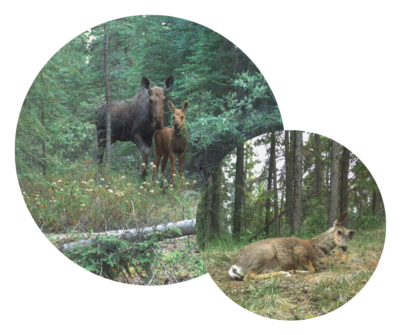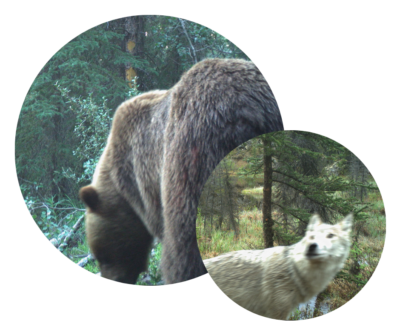Many species tolerate the existing roads in McIntyre Creek. Why is CPAWS Yukon opposing a new road?

Written by Malkolm Boothroyd, Campaigns Coordinator
Whitehorse’s Official Community Plan will help to determine the future of McIntyre Creek/Chasàn Chùa. Your input can shape this plan! Email your thoughts to ocp@whitehorse.ca or fill out the City’s survey.
Coyote pups tumbling about in a clearing. A calf moose trotting behind its mother’s towering legs. A pine marten standing up its hind legs and looking straight into the camera. These are a few of the thousands of images captured by the trail cameras we set up throughout McIntyre Creek last summer, and have been sharing on social media. But there was more to this project than documenting the adorable wildlife of McIntyre Creek.
We set out on our wildlife study because we wanted to understand how developments like roads and subdivisions impact the wildlife that depend on the creek. Last week the City of Whitehorse released its draft Official Community Plan—promising to work towards a park in McIntyre Creek—but also leaving the door open to a major road through the lower section of the creek. The Official Community Plan will help determine the future of McIntyre Creek, which means it’s a good time to take stock of our wildlife study.

We’re part way through analyzing our data. It surprised me, but in most cases roads didn’t have a statistically significant impact on wildlife distributions. One exception was moose, which avoided areas with lots of roads, while deer were more likely to be found in heavily roaded areas. Deer have a higher tolerance of people than other ungulates, and may favour places with higher human densities in part because their predators avoid these areas. Species like lynx, coyotes and snowshoe hares seemed largely unaffected by roads.
Our trail cameras only recorded a few grizzly bears and one single wolf, all in parts of McIntyre Creek with few roads. It’s possible that roads are negatively impacting these large predators, but our sample size was much too small to draw any statistical conclusions. These are preliminary results, and we haven’t finished analyzing all of the data we collected. These findings are definitely not what I expected, but they’re good news. It means that there’s still a lot of really good wildlife habitat throughout McIntyre Creek, and that most species can tolerate the existing amount of roads in the area.

There are lots of things this study doesn’t tell us. Our study can’t predict the impacts of building a new road through McIntyre Creek, or expanding the Alaska Highway and Mountainview Drive to accommodate more traffic. Building a third major road would be a big change for McIntyre Creek, and one that there’s no going back from. We’re fortunate to live in a city that is so rich in wildlife and wild spaces, but that could change if we take it for granted.
There are other reasons to be skeptical of a new road through McIntyre Creek. How will building a road from the roundabout on Mountainview Drive to the Alaska Highway near Kopper King alleviate traffic congestion? Anybody driving from Whistlebend into Whitehorse would be adding an extra kilometer onto their commute along with two left hand turns across busy roads, only to end up at the top of Two Mile Hill. There are values-based considerations too, like cutting a major road through an area full of walking and biking trails. And of course there’s the climate emergency. Building a new road strikes me as a 20th century solution to traffic problems— when the future of sustainable urban development depends on mass public transit and active transport.

The City will have to think about the road from a lot of angles—how wildlife use the creek, the connections that people hold to this place, and what the future of transportation looks like in Whitehorse. The results of our wildlife study may not lend themselves to making simple, decisive statements about the impacts of the proposed road on the wildlife of McIntyre Creek, but that’s fine. The prospect of a road through McIntyre Creek has always been a complicated question, and one that will reflect Whitehorse’s priorities as a City.
What’s your vision for the future of McIntyre Creek? A busy new road could change what we love about McIntyre Creek. We have a week to tell the City we don’t want it. Send an email to ocp@whitehorse.ca, or fill out the City’s survey by June 12th.


